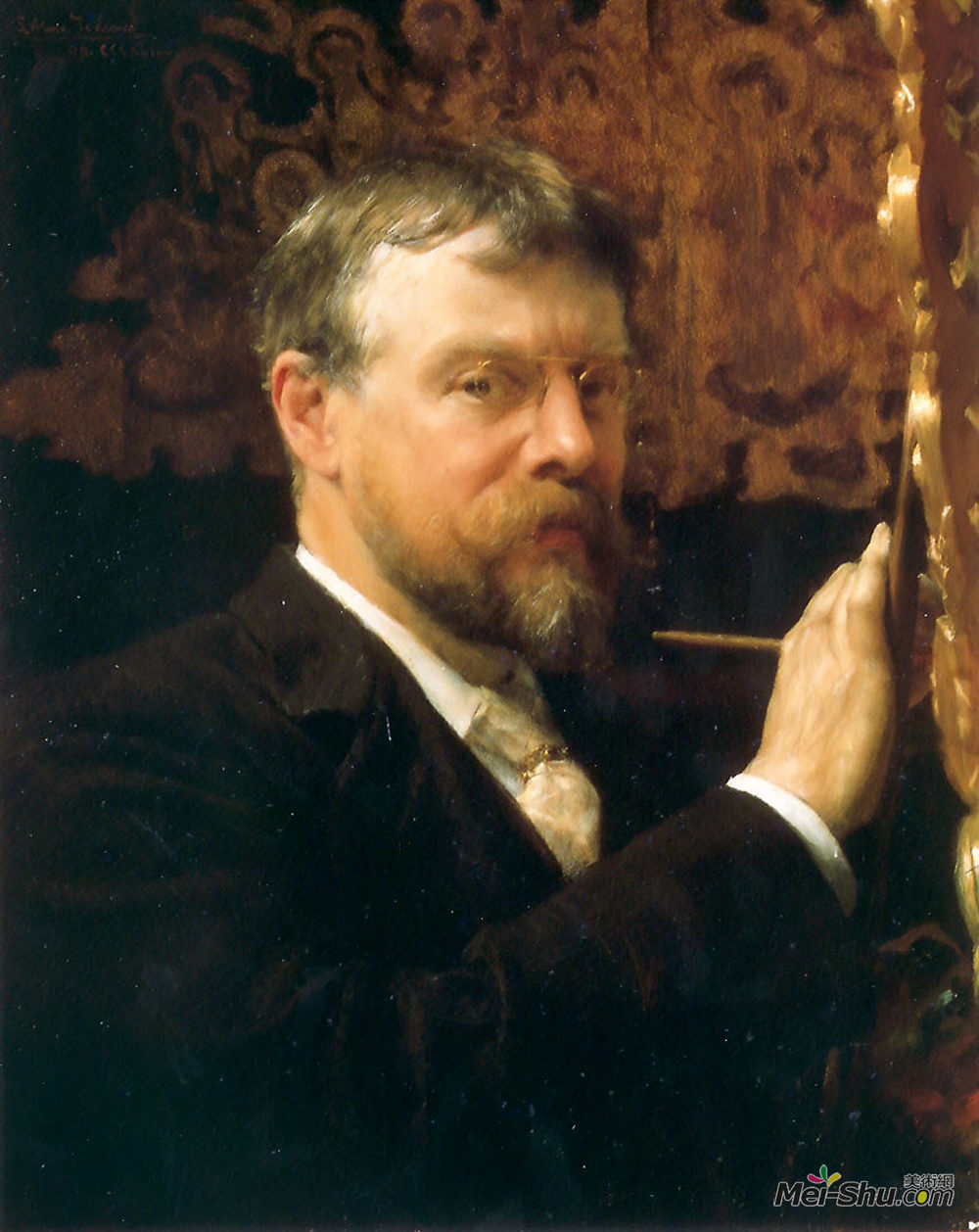
劳伦斯阿尔玛- tadema(Sir Lawrence Alma-Tadema)
艺术家: 劳伦斯阿尔玛- tadema
生于: 1836年1月08日;荷兰德龙赖普
卒于: 1912年6月25日;德国威斯巴登
国籍: 荷兰
流派: 浪漫主义,新古典主义
领域: 绘画
影响: 米哈伊尔·弗贝鲁尔
机构: 慕尼黑(慕尼黑美术学院学院),伦敦,英国皇家美术学院,安特卫普,比利时
罗伦斯.阿玛.泰德玛是十九世纪下旬英国最著名的浪漫主义艺术家之一。他出生在荷兰作为Laurens Tadema,到镇上的公证家庭。后来,当他试图在艺术界占有一席之地时,他把他的名字的拼写改成了更英语的“劳伦斯”,并把他的中间名“阿尔玛”作为他姓的一部分,所以他将被列入展览目录中的“A”之列。小时候,阿尔玛-塔德玛决定从事律师职业,但是他十五岁时精神和身体都垮了。他被诊断为消耗,短暂的时间生活,因此可以自由地追求休闲和快乐的生活。一旦留给他自己的手段,他决定学习艺术,因为他的母亲支付了艺术课在他的早期童年,这是他的兴趣之一。1852,他重获健康并在安特卫普皇家学院学习,在那里他赢得了几项受人尊敬的奖项。他的第一个主要作品在1858展出,它赢得了很多批评的赞扬,并创造了艺术世界的轰动。到了1862岁,他在自己的工作室里开创了自己的艺术生涯。1869岁时,Alma Tadema失去了妻子六年的天花。郁郁寡欢,他停止绘画,他的健康也在衰退。在医生的建议下,他前往英国进行医学诊断,在那里他被邀请到一位画家福特·马多克斯·布朗的家中。就在这里,他注视着当时17岁的Laura Theresa Epps,疯狂地爱上了她。阿尔玛•塔德玛利用普法战争的爆发来重新安置到英国,在那里他毫不浪费时间联系劳拉并在私人艺术课上与她签约。正是在Alma Tadema提出的这些教训之一,他们不久后结婚。Alma Tadema 34岁,新娘18岁。阿尔玛•塔德玛一生中的下一段时间都在欧洲旅行,享受着他绘画的成功。作为一个男人,他性格外向,热情的个性和淘气的感觉使他暴躁的脾气减轻了。他是一个完美主义者和痴迷的工人,他还创新了一种新的编号技术,这使得伪造者很难放弃非原创的作品。晚年,尽管他的艺术产出有所下降,但他仍在继续取得成功,最终成为十九世纪最富有的画家之一。他于1899在英国被授予爵位。1912,Alma Tadema前往德国接受胃溃疡治疗,76岁时在德国逝世。他死后,他的工作大多被忽视了。由于艺术发生了巨大的变化,Alma Tadema的艺术天才直到20世纪60年代才重新进入公众的视野,他的细致作品已经成为好莱坞几十部电影的素材。
Artist :Sir Lawrence Alma-Tadema
Additional Name :Sir Lawrence Alma-Tadema
Born : Dronrijp, Netherlands
Died : Wiesbaden, Germany
Nationality :Dutch
Art Movement :Romanticism,Neoclassicism
Influenced on :mikhail-vrubel
Art institution :Akademie der Bildenden Künste München (Munich Academy), Munich, Germany,Royal Academy of Fine Arts, Antwerp, Belgium
Lawrence Alma-Tadema is one of the most highly renowned romantic artists of late 19th century Britain. He was born in the Netherlands as Laurens Tadema, to the family of the town notary. Later, as he tried to make his niche in the art world, he changed the spelling of his first name to the more English “Lawrence,” and included his middle name “Alma” as part of his surname, so he would be listed among the “A’s” in exhibition catalogues.
As a child, it was decided that Alma-Tadema would pursue the career of a lawyer, but he suffered a mental and physical breakdown when he was fifteen years old. He was diagnosed as consumptive, given a short time to live, and thus free to pursue a life of leisure and pleasure. Once left to his own devices, he decided to study art, as his mother had paid for art lessons in his earlier childhood and it was one of his interests. He regained his health and studied at the Royal Academy of Antwerp in 1852, where he won several respected awards. His first major work was exhibited in 1858, and it won much critical praise, and creating a sensation in the art world. By 1862, he set own in his own studio to pursue his individual career in art.
In 1869, Alma-Tadema lost his wife of six years to smallpox. Disconsolate and depressed, he ceased painting and his health was failing. Under the advice of his physician, he traveled to England for a medical diagnosis, where he was invited to the house of a fellow painter, Ford Madox Brown. It was here that he laid eyes on Laura Theresa Epps, who was 17 at the time, and fell madly in love with her. Alma-Tadema took advantage of the outbreak of the Franco-Prussian war to relocate to England, where he wasted no time contacting Laura and contracting her in private art lessons. It was during one of these lessons that Alma-Tadema proposed, and they were married shortly thereafter. Alma-Tadema was 34 years old, and the bride 18.
Alma-Tadema spent the next part of his life traveling through Europe, and enjoying the continued success of his paintings. As a man, his bursts of bad temper were eased by his extroverted, warm personality and sense of mischief. A perfectionist and obsessive worker, he also innovated a new numbering technique, which made it difficult for forgers to pass off unoriginal works. In his later years, although his artistic output decreased somewhat, he enjoyed continued success, eventually becoming one of the wealthiest painters of the 19th century. He was knighted in England in 1899.
In 1912, Alma-Tadema traveled to Germany to undergo treatment for stomach ulcer, and died in Germany at the age of 76. After his death, his work was mostly ignored. Due to the drastic changes taking place in art, Alma-Tadema’s artistic genius would not come into the public eye again until the 1960s. His meticulous work had since been used as source material for dozens of Hollywood movies.